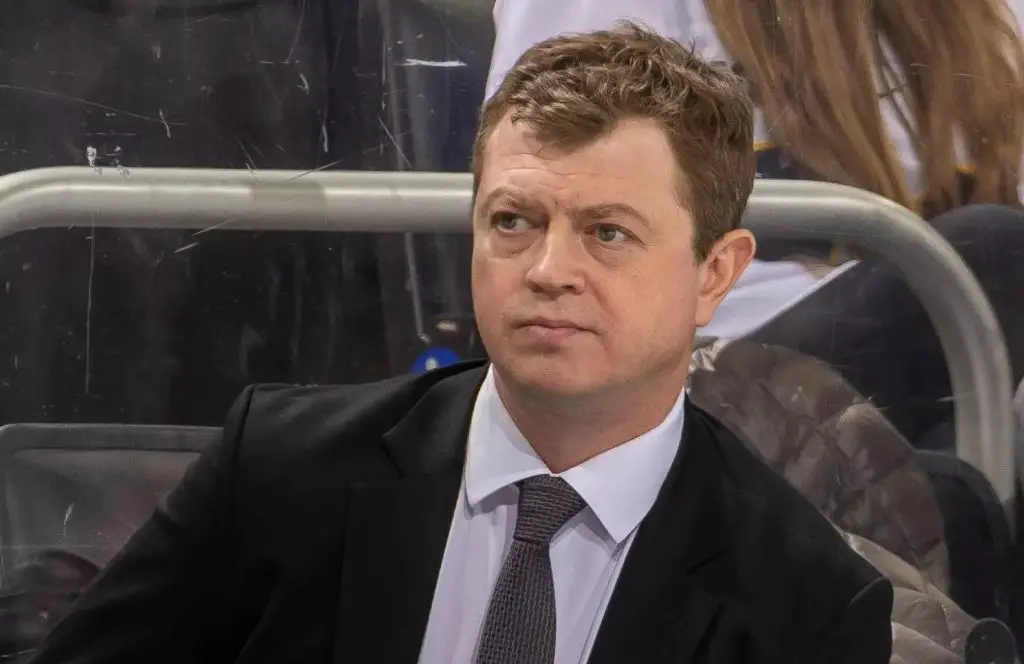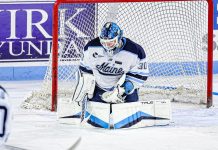
Each week during the season, we look at the big events and big games around Division I men’s college hockey in Tuesday Morning Quarterback.
Dan: I woke up this morning to the crispy feel of leaves under my feet and 30-degree temperatures in the air. It was fall in New England, the perfect time of year, and I 100 percent left the back door wide-open in my house. So my living room needs a leaf blower, and it was really cold.
But that’s not what we’re here to talk about.
It’s Tuesday, and that means it’s time to recap the college hockey weekend. I’m still buzzing over here about Boston College’s come-from-behind win over Western Michigan, but the Denver-Wisconsin series kept us once again ironed into Denver as No. 1 and BC as No. 2 – though BC lost its usual first place votes.
It’s early, but those two teams are playing head-and-shoulders hockey above everyone else (worth noting that Minnesota and Cornell had the two non-Denver first place votes).
As I welcome my cohost for the week, Paula, I know you kept a close eye on the DU series against the Badgers… what’s standing out about those two teams in particular, or maybe it’s just Denver?
Paula: Denver hasn’t lost a step since winning the 2024 national championship. Including their six wins this season, the Pioneers are riding a 15-game win streak, dating back to a one-goal loss to Colorado College Mar. 8. It’s extraordinary. They feel like a juggernaut already and the season isn’t a month old.
I’m impressed with every aspect of their game. Through six games, three players – Aidan Thompson, Carter King, and Sam Harris – have a combined 15 goals, each on track to hit 10 before the end of November. Thompson had 11 total last season, King had 15 and Harris 14. If they continue to score at this pace, they’ll each have career seasons.
Then there’s Jack Devine, with his single goal so far – but 13 assists. He’s everywhere on the ice. Devine had an amazing year last season with 27 goals and 29 assists. He’s already near half his assist total from a year ago, so he’s certainly upped his offensive game in specific ways. I can’t imagine what his season will be like when he starts to get the goals, too.
Matt Davis (1.67 GAA, .930 SV%) has been outstanding, and the team defense in front of him has been solid.
Some people might argue that the Pioneers’ schedule to start the season has been on the lighter side, but I am not among those folks. A trip to Anchorage to open play followed by two top-20 opponents is a good tune-up. They have Yale and Lindenwood before they face North Dakota on the road Nov. 15-16 to begin NCHC play, but even if the teams they’re facing early on aren’t as challenging as their NCHC competition surely will be, the continued winning builds confidence and helps the Pioneers work out some early issues.
They’re poised to make another national championship run.
Wisconsin. Ah, Wisconsin.
The Badgers are struggling to follow up their 26-win season of 2023-24, Mike Hastings’ first behind the Wisconsin bench. They lost four 10-plus goal scorers from a season ago as well as goaltender Kyle McClellan. They’ve scored just 10 goals through their six games (1-5-0) and they’ve allowed 20. That’s a losing recipe, and Hastings and his staff know it.
Here’s the thing, though: Mike Hastings has never coached a team to a losing season in his entire career. I’m confident that the Badgers will somehow muster and improve, but this slow start will bite them in the end.
I’m sure you didn’t expect a dissertation on Denver. I’m just so impressed with them. They’re not the only team that bedazzles me in the early going. Who’s on your radar?
Dan: Let me build this out from a foundational level because we all know I’m going with Boston College.
BC lost Will Smith and Cutter Gauthier from last year’s roster but returned nearly every major piece from a team that advanced to last year’s national championship game. Certain veteran leaders like Jack Malone graduated, but bringing back Jacob Fowler in net, Eamon Powerll on the blue line, Gabe Perreault, Ryan Leonard, Oskar Jellvik, Aran Minnetian, and others made this team good enough to compete at a high level before it ever added presumptive No. 1 overall pick James Hagens and players like Teddy Stiga and Dean Letourneau.
Building off that baseline, there were still questions about how well BC could move past its magic from last season because the players fit so easily and so well into last year’s team, but this past weekend’s win over Western Michigan illustrated the pure height of the roster’s ceiling. This team trailed Western – which is a very good team – by two goals in the first period and spent roughly 35 minutes clawing its way back before Leonard scored the game-winning, go-ahead goal in the last minute. Watching replays, it’s not even about getting open for a wide-open goal mouth or the perfect pass from Perreault. To me, it was about the play that started at the blue line and brought BC from defensive neutral zone to forecheck to turnover to pass to 2-man break-in to pass to score. Gritty but agile, it was perfect.
I suppose I need to throw a quick disclaimer that I’m affiliated with the BC hockey program through the athletics department – something Chris Lerch likes to laugh about because I’m required to work for 84 different universities in the Greater Boston area.
I want to jump back to Wisconsin, though, because I’m not mashing the panic button about that team. Coach Hastings made a mention about needing to “tear it down” for a rebuild, but this week’s games against Denver wasn’t exactly the best time to reformat or retool a team on the fly. That’s not being critical of Wisconsin – I think it’s extremely difficult for teams to beat Denver when they’re playing top-flight hockey and aren’t facing tactical problems. So for Wisconsin to walk into Magness without its mojo in the right direction is an impossible ask.
I can’t remember a team changing its stripes on the fly, so I don’t want to read too much into his comments to see Wisconsin suddenly change its style, but are there programs in recent memory that you can recall changing their identity or altering their style on the fly to rapid success? For me, the prime example is always Robert Morris, which was 2-10-2 after tying Mercyhurst to end its first half. After losing both ends of the Three Rivers Classic, a 2-12-2 team went 17-6-3 over the rest of its season and won the Atlantic Hockey championship.
Paula: Rapid success? I guess that depends on how you define “rapid.” Also, the change of style usually accompanies a new head coach.
One rapid-ish success story is Michigan State under Adam Nightingale. The Spartans were an eight-win team in Danton Cole’s last season as coach (2021-22) and improved to 18-18-2 overall the following year in Nightingale’s first season. In Nightingale’s second season – last year – Michigan State was Big Ten regular-season and playoff champion, and the Spartans made their first NCAA tournament appearance since 2012.
That’s nearly as fast as it gets in college hockey, and it’s due to Nightingale’s and his staff’s holistic approach to player development. That model of player development is changing college hockey, and for the better.
A slightly less meteoric rise is Maine under Ben Barr. Red Gedron’s final season with the Black Bears was 2020-21, the season stunted by COVID, so it’s difficult to use that three-win year as a baseline, and Barr’s first season was rough. In his second season, Barr brought the Black Bears to a .411 win percentage, and last year Maine finished third in Hockey East with an overall record of 23-12-2 and the Black Bears’ first NCAA appearance since 2012.
Now look at Maine. It’s early still, but Maine’s one of four undefeated programs (4-0-1) and the Black Bears have averaged four goals a game. While it’s too soon to put much stock in the PairWise, Maine currently sits at No. 4. This early PWR success may make a huge difference next March, after the Black Bears have completed a really competitive Hockey East season.
Two under-the-radar teams I’m watching are Union and Ohio State, two teams that have started fast. In spite of a 6-1-0 record and only one game in which they’ve scored fewer than three goals (averaging 4.67 per game), the Garnet Chargers have yet to crack the USCHO.com Poll this season, although they did earn 59 votes this week including one from me.
Their only loss was 4-1 to Boston University, a game in which they were outshot 44-37 and gave up two power-play goals. They did start their season with an exhibition loss to another ranked team, Providence.
Union will face some tough competition when ECAC play begins, but – like Denver – this early tune-up will serve the Garnet Chargers well.
The Buckeyes surprise me more than a little. I thought I saw Ohio State improve a lot in the second half of last season without many wins to show for it. Now they’ve been building confidence as well, especially with a solid duo of Logan Terness and Kristoffer Eberly in net. The Big Ten is going to be wicked hard this season, so the early success – including in the PWR, where Ohio State stands at No. 8 – is encouraging.
Programs like Union and Ohio State and even Colorado College, another team undefeated so far, suffer from trust issues, I think. Even Maine, to some extent. If you’re not Denver, Minnesota or North Dakota, or if you don’t have a Boston in front of your name, there isn’t much benefit of the doubt given.
I like when the sleepers and underdogs prove everyone wrong.
Dan: Maine is one of those teams that makes college hockey better. When Maine is good, college hockey is good. Also… best jersey in the game.
Holistic coaching triggered something in my brain because I’m increasingly realizing how different the coaching game is becoming. Sure, there are newer elements in NIL and that stuff, but player development changed to include the whole person beyond just the ice rink.
Coaches taking that approach are going to succeed, and I’m excited to see how it continues to play out. I’ve talked to so many coaches who mention things like breathing, mental wellness, and stress-related parts of the game over simple tactics. It’s encouraging that we’re heading in that direction to know how to push, not just to push, our players and staff members.
Paula: We are witnessing a shift in approaches to coaching, and I think that in addition to leading to more success for teams at the college level, players developed in a program with a more holistic approach will be better prepared for professional hockey, if that’s where they want to go.
Back to Nightingale, part of his success at Michigan State is because of his success with player development for the U.S. National Team program and elsewhere.
The same thing can be said for Brandon Naurato, who ushered the Wolverines through a time that was genuinely awful for many players while maintaining an impressive level of hockey success. His background in player development with the Red Wings was key.
And that’s the thing: many NHL teams focus on player development now in ways that were unheard of even six or seven years ago, giving young players a place to succeed. It’s sound business, given the money invested in young players, but it’s also a more ethical thing to do.
That it’s trickled down to the NCAA level benefits both college and professional players plus the teams they play for. I hate the term “win-win,” but it really is.
Also, Maine’s jersey is sweet – and I have family roots in Maine, so I’m partial to the Black Bears – and I am especially fond of any jersey with an animal mascot, but since my days covering the old CCHA, always been enamored of Lake Superior State’s jerseys.
Dan, we’ll save the jersey talk for another time and place.


